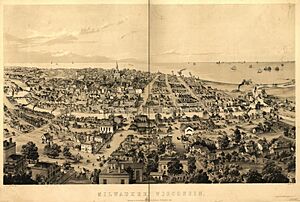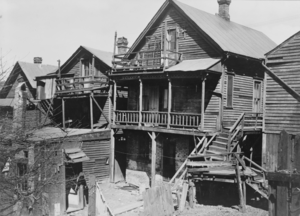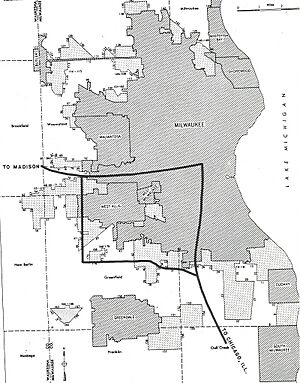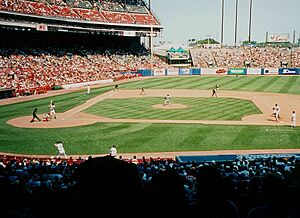History of Milwaukee facts for kids
Milwaukee, a city in Wisconsin, has a long and interesting history. For over 160 years, people from many different places have moved here. These include Germans, Irish, French, Poles, and people from other parts of the United States. Milwaukee is also known for its unique politics, like a strong Socialist movement, and its industries, such as making machines, cheese, and beer.
Contents
Early History of Milwaukee
The first people known to live in the Milwaukee area were several Native American tribes. These included the Menominee, Fox, Mascouten, Sauk, Potawatomi, and Ojibwe tribes. The Ho-Chunk tribe also lived here. Many of these groups had lived near Green Bay before moving to Milwaukee when Europeans started arriving.
The name "Milwaukee" comes from an Algonquian word. It means "Good," "Beautiful," and "Pleasant Land." It can also mean "Gathering place by the water."
French missionaries and traders first visited the area in the late 1600s and 1700s. A French explorer named Robert La Salle was likely the first white person to see Milwaukee in October 1679. Before the 1800s, Milwaukee was mostly home to Native Americans.
The Native Americans in Milwaukee played a part in major wars on the American continent. During the French and Indian War, some Ojibwa and Potawatomi people from the Lake Michigan area joined the French. In the American Revolutionary War, the local Native Americans mostly stayed loyal to the American cause.
Around the end of the 1700s, the first white fur trader settled in Milwaukee. His name was Jean Baptiste Mirandeau. In 1795, he and Jacques Vieau started a fur-trading post near the Menomonee River. Mirandeau lived there all year, and Vieau brought supplies each spring. Mirandeau died in 1820 or 1821. He was the first white person buried in the city. The trading post was on a trail between Chicago and Green Bay. It was located where Mitchell Park is today. Vieau married the granddaughter of a Native American chief. Their family helped create a mixed-heritage population. By 1820, Milwaukee was largely a settlement of people with both Native American and European roots.
Milwaukee's Founding and Early Growth
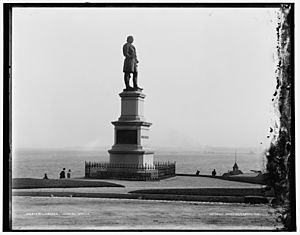
Milwaukee has three main "founding fathers." They are Solomon Juneau, Byron Kilbourn, and George H. Walker. Solomon Juneau was the first to arrive, in 1818. Juneau was French Canadian. In 1820, he married Josette Vieau, who was Jacques Vieau's daughter. Vieau later sold his trading post to Juneau and Josette. Josette is sometimes called the "founding mother of Milwaukee."
In 1825, the Juneaus moved the trading post. They set it up on the east side of the Milwaukee River, near Lake Michigan. They started a town there called Juneau's Side, or Juneautown. This new town quickly attracted settlers from the Eastern United States and Europe.
Soon after, Byron Kilbourn settled on the west side of the Milwaukee River. He wanted his town to be better than Juneau's. Kilbourn started Kilbourntown. He made sure that the streets in his town did not line up with those on the east side. This is why many angled bridges still exist in Milwaukee today. Kilbourn even made maps that only showed Kilbourntown. These maps made it seem like Juneautown did not exist.
The third important builder was George H. Walker. He claimed land south of the Milwaukee River. In 1834, he built a log house there. This area grew and became known as Walker's Point.
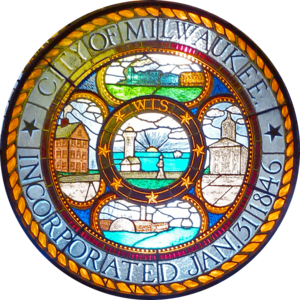
The closeness of these three towns caused problems in 1845. A bridge was built between Kilbourntown and Juneautown. Kilbourn and his supporters saw this bridge as a threat. Kilbourn ended up destroying part of the bridge. Over the next few weeks, small fights broke out between people from the two towns. No one died, but several people were hurt. This event is known as the Milwaukee Bridge War. After the war, the towns tried harder to work together.
By the 1840s, the three towns had grown a lot. On January 31, 1846, they joined together to form the City of Milwaukee. Solomon Juneau was elected as the city's first mayor. Many German immigrants helped the city's population grow during the 1840s. More Germans continued to move to the area in the following decades.
Milwaukee became known as "Deutsches Athen," meaning "German Athens." Even into the 1900s, there were more German speakers and German newspapers than English ones in the city. To this day, the Milwaukee phone book has many pages of names like Schmitt or Schmidt.
In the mid-1800s, Milwaukee got the nickname "Cream City." This name came from the cream-colored bricks made from clay in the Menomonee River Valley. These bricks were used in many buildings. At its busiest, Milwaukee made 15 million bricks a year. A third of these bricks were sent out of the state.
Milwaukee in the Late 1800s
During the mid-to-late 1800s, many German immigrants came to Wisconsin and Milwaukee. They were escaping the Revolutions of 1848. In Wisconsin, they found affordable land and the freedoms they wanted. German culture and influence became very strong in the Milwaukee area.
Solomon Juneau died on November 14, 1856, at age 63.
The Milwaukee Bar Association was started in 1858. It is one of the oldest groups for lawyers in the United States. Today, it has over 2,600 members.

On May 5, 1886, an event called the Bay View Massacre happened. Steelworkers were on strike and marching toward a factory in the Bay View area. National Guardsmen, following orders from the Wisconsin Governor, shot into the crowd. Seven people were killed.
The late 1800s also saw the creation of Milwaukee's first suburbs. Bay View was an independent village from 1879 to 1886. In 1892, Whitefish Bay, South Milwaukee, and Wauwatosa became towns. Then came Cudahy (1895), North Milwaukee (1897), and East Milwaukee (later called Shorewood) in 1900. In the early 1900s, West Allis (1902) and West Milwaukee (1906) were added. These were the first "inner-ring" suburbs.
Generally, suburbs along the north shore of Lake Michigan were mostly homes for wealthier people. Suburbs on the south shore were more industrial and for working-class families. The western suburbs were a mix. North Milwaukee and West Allis were mainly industrial. Wauwatosa was mostly residential. Wauwatosa was known as Milwaukee's first "bedroom suburb." This means many people lived there but worked in Milwaukee.
In 1895, the Milwaukee City Hall was finished. It had 15 stories and was 393 feet tall. When it was built, City Hall was the tallest building in the world that people could live or work in. It held this title until 1899. It was also the tallest government building until 1901.
Milwaukee in the Early 1900s
In the first half of the 1900s, Milwaukee was a center for the socialist movement in the United States. Milwaukee elected three Socialist mayors during this time. They were Emil Seidel (1910–1912), Daniel Hoan (1916–1940), and Frank Zeidler (1948–1960). Milwaukee is the only major city in the country to have had so many Socialist mayors.
These Milwaukee Socialists were often called "Sewer Socialists." This name came from their practical way of governing. They focused on improving neighborhoods and factories with new sanitation systems. They also worked on city-owned water and power systems and better education. During this time, Mayor Daniel Hoan started the country's first public housing project, called Garden Homes. The Socialists' influence began to fade in the late 1950s. This was during a time known as the "red scare."
On November 24, 1917, a large bomb exploded at the central police station in Milwaukee. Nine police officers and one civilian were killed. At the time, this was the deadliest single event for law enforcement in the nation's history.
During this period, a growing community of African-Americans moved from the South to Milwaukee. They formed a neighborhood known as Bronzeville. This area became famous for its jazz clubs and music spots. It attracted both local and national musicians like B.B. King and Ella Fitzgerald. Bronzeville's importance lessened after World War II. This was because a major highway was built, which broke up the neighborhood. Today, the area is seeing a revival. New businesses, restaurants, and clubs are opening, trying to bring back its past fame.
In 1953, over 7,000 workers at six breweries in Milwaukee went on strike. The strike lasted for more than 76 days.
By the late 1950s, Milwaukee had grown a lot, like many industrial cities in the North. It had a dense population. People had moved there from European countries, from the Southern United States, and from other parts of Wisconsin.
As Milwaukee's suburbs grew, people started moving out of the city center. Milwaukee then added surrounding lands to the city. This helped the city keep some of its tax money. It also provided city services to these new areas. The first plan for Wisconsin's highway system was made in 1945. It aimed to help with Milwaukee's traffic. But construction did not start until the late 1950s.
Milwaukee from 1960 to 1995
Milwaukee's population was highest in 1960. The US Census counted 741,324 people. This made Milwaukee the 11th largest city in America. Milwaukee made its last boundary changes in the same year. This set the city's borders as they are today.
In 1967, a riot happened in the city. The 1967 Milwaukee riot was one of many race riots across U.S. cities that summer. In Milwaukee, African American residents were upset about slow progress in ending housing discrimination and police brutality. The riot began on the evening of July 30, 1967. A fight between teenagers grew into a full riot when police arrived. Soon, fires, looting, and shooting were happening on the North Side of the city.
By 1970, the city's population had dropped to 717,099. It was then the 12th largest American city. By 2000, it was the 19th largest, with 596,974 people. This population drop was due to several reasons. Starting in the late 1960s, Milwaukee lost many factory jobs. This was common in cities in the "rust belt" region. Also, many white families moved out of the city to the suburbs. This is known as "white flight."
The building of Milwaukee's interstate highway system began in 1964. The first seven miles of I-94 were finished then. This led to more people moving out of the city. Suburbs in southeastern Wisconsin continued to grow along the highways. They offered an alternative to crowded city living. However, people started to protest against the freeway in the late 1960s and early 1970s. This almost stopped freeway construction in Milwaukee. The city ended up with only about half of the highways that were planned.
Milwaukee in Recent Years
In recent years, Milwaukee has worked to improve its economy, neighborhoods, and image. This has led to the rebirth of areas like the Historic Third Ward, the East Side, and more recently, Bay View. The city has also attracted new businesses to its downtown area. Marquette University has invested in major projects in the Marquette Hill neighborhood. These include a "campus town" and new academic buildings.
The city continues to plan for new projects to bring more life to the area. Because of its efforts to save its history, Milwaukee was named one of the "Dozen Distinctive Destinations" in 2006. This award came from the National Trust for Historic Preservation.
In the early 2000s, the city has seen many construction projects. This level of building has not been seen since the 1960s.


